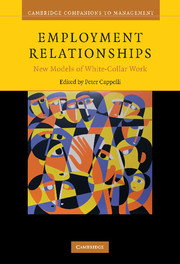Book contents
- Frontmatter
- Contents
- List of figures
- List of tables
- List of contributors
- Foreword
- 1 Introduction
- 2 Corporate restructuring and the employment relationship
- 3 The up and out in organizations
- 4 In the pursuit of quality and quantity: the competing demands in call centers
- 5 Three's a crowd? Understanding triadic employment relationships
- 6 The changed world of large law firms and their lawyers: an opportune context for organizational researchers
- 7 The upside of bureaucracy: unintended benefits for professional careers
- Index
- References
5 - Three's a crowd? Understanding triadic employment relationships
Published online by Cambridge University Press: 02 December 2009
- Frontmatter
- Contents
- List of figures
- List of tables
- List of contributors
- Foreword
- 1 Introduction
- 2 Corporate restructuring and the employment relationship
- 3 The up and out in organizations
- 4 In the pursuit of quality and quantity: the competing demands in call centers
- 5 Three's a crowd? Understanding triadic employment relationships
- 6 The changed world of large law firms and their lawyers: an opportune context for organizational researchers
- 7 The upside of bureaucracy: unintended benefits for professional careers
- Index
- References
Summary
Introduction
There are many facets to the typical employment relationship. At its very simplest, employment involves the exchange of labor for compensation. Nevertheless, employment relationships also involve control of the worker by the firm, the acquisition of skills through experience and training, learning about each others' qualities and intentions, and career progression as the worker moves from role to role within the organization. In addition, employment usually imposes a variety of specific legal obligations on both employer and employee. Traditionally, these obligations have been combined into a single relationship between worker and firm.
In recent years, however, we have seen the growth of “triadic” employment arrangements, in which important characteristics of employment are divided among workers' relationships with two firms: a “client” and an “intermediary.” The intermediary generally acts as the legal employer of the worker, but the actual work is performed at a client site. Consider, for example, employment relationships for temporary agency workers. Legally, the worker is employed by the agency, which also provides the worker with compensation and any benefits. Career progression for the worker often results from the worker being assigned by the agency to roles in different clients. The worker's relationship with the client also has clear elements of an employment tie, however: the worker provides labor to the client at its site; the worker often also accepts substantial control by the client over his or her work. We cannot therefore understand how the worker is employed without examining both these ties.
- Type
- Chapter
- Information
- Employment RelationshipsNew Models of White-Collar Work, pp. 142 - 178Publisher: Cambridge University PressPrint publication year: 2008
References
- 26
- Cited by



